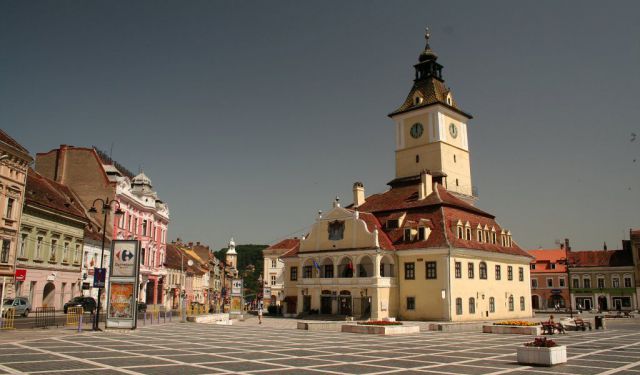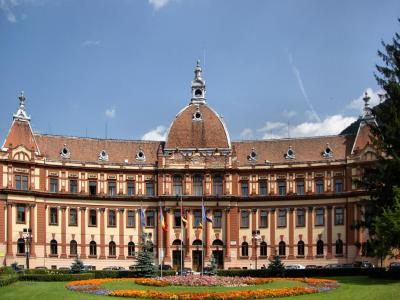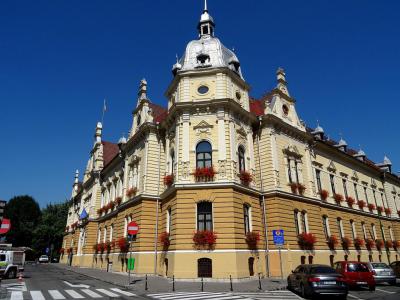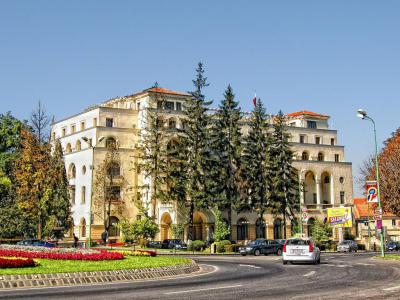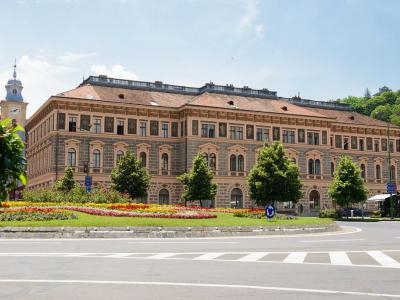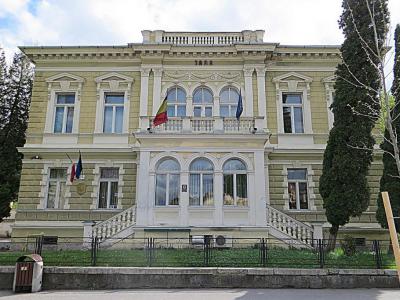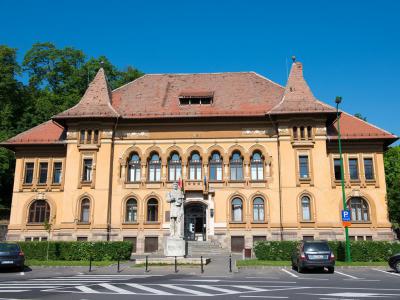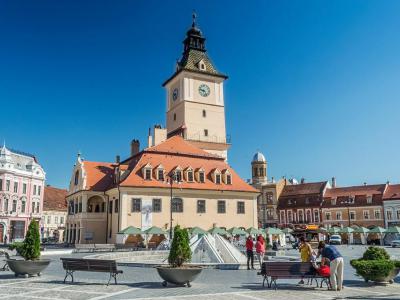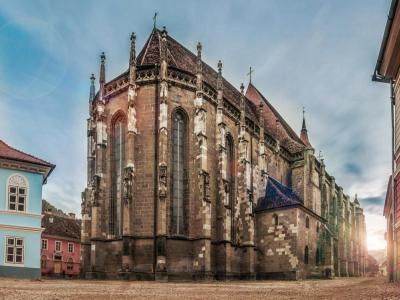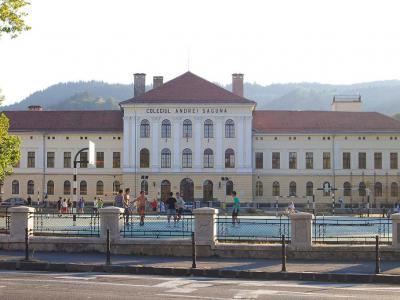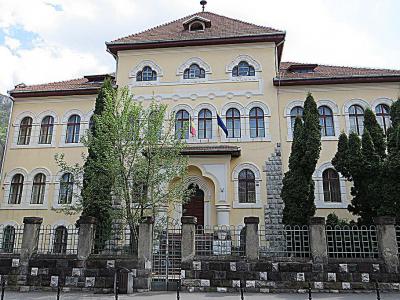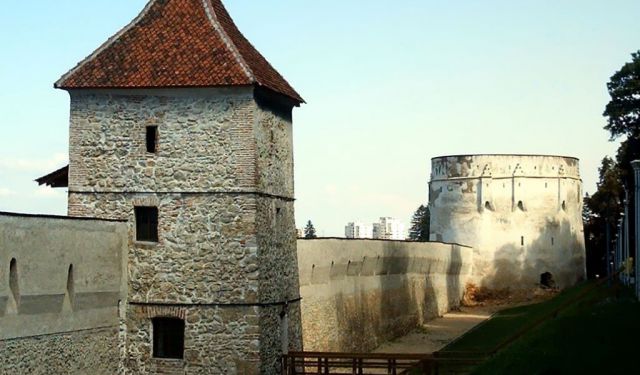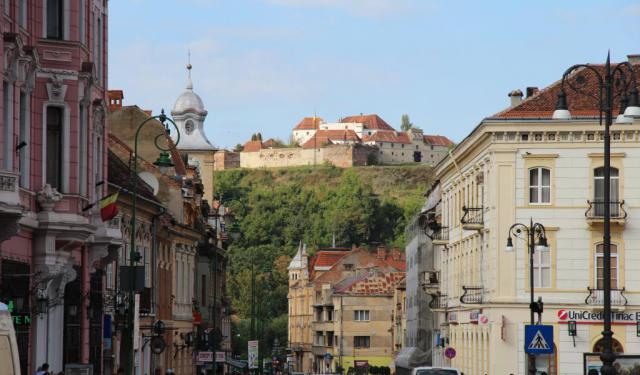Brasov's Architectural Jewels Tour (Self Guided), Brasov
Some may be pleasantly surprised to discover in Brasov, Romania, a treasure trove of architectural marvels. Indeed, spanning medieval through modern periods, the local architecture is quite impressive in terms of style variety.
Most of Brasov's architectural monuments are headquarters of local administration, museums, or other cultural venues. Among these jewels, there are several notable landmarks in particular not to be missed.
The Brasov Prefecture, an imposing structure, stands as a symbol of administrative authority in the city, showcasing a Neo-Baroque style reminiscent of historic monuments in Budapest, Hungary. Nearby, the City Hall (Primaria) exemplifies Art-Nouveau architecture with its intricate facade and an Austro-Hungarian Imperial influence evident throughout.
The House of Army (Casa Armatei) exudes grandeur and was built between two World Wars in the 20th century, blending modern and Romanesque styles.
Adjacent to it, the Rectorat, or Transylvanian University Administration Office, is a neo-Renaissance masterpiece that stands as a beacon of education and intellectual pursuit. The nighttime illumination adds another layer of its allure.
Baiulescu House (Casa Baiulescu) showcases exquisite Modern Romanesque architecture, taking up the site of one of Brasov's legendary bastions. Meanwhile, the George Baritiu Library stands as a sanctuary of knowledge, housed in an eye-catching building that blends traditional Romanian elements with Art Nouveau influences.
The Council House (Casa Sfatului) serves as a testament to Brasov's medieval past. Originally built in the 16th century and replaced in the 20th, it is a focal point in the Old Town.
The iconic Black Church (Biserica Neagra) dominates the skyline with its imposing Gothic structure and holds a special place in the city's heritage.
Further enriching the architectural landscape are institutions like Andrei Saguna College and Andrei Muresanu Lyceum, which have played pivotal roles in shaping the city's cultural and educational landscape.
The above landmarks are fit to impress in equal measure an architecture buff and a curious traveler. Exploring Brasov's architectural jewels promises a culturally enriching journey. So, whenever you can, take it!
Most of Brasov's architectural monuments are headquarters of local administration, museums, or other cultural venues. Among these jewels, there are several notable landmarks in particular not to be missed.
The Brasov Prefecture, an imposing structure, stands as a symbol of administrative authority in the city, showcasing a Neo-Baroque style reminiscent of historic monuments in Budapest, Hungary. Nearby, the City Hall (Primaria) exemplifies Art-Nouveau architecture with its intricate facade and an Austro-Hungarian Imperial influence evident throughout.
The House of Army (Casa Armatei) exudes grandeur and was built between two World Wars in the 20th century, blending modern and Romanesque styles.
Adjacent to it, the Rectorat, or Transylvanian University Administration Office, is a neo-Renaissance masterpiece that stands as a beacon of education and intellectual pursuit. The nighttime illumination adds another layer of its allure.
Baiulescu House (Casa Baiulescu) showcases exquisite Modern Romanesque architecture, taking up the site of one of Brasov's legendary bastions. Meanwhile, the George Baritiu Library stands as a sanctuary of knowledge, housed in an eye-catching building that blends traditional Romanian elements with Art Nouveau influences.
The Council House (Casa Sfatului) serves as a testament to Brasov's medieval past. Originally built in the 16th century and replaced in the 20th, it is a focal point in the Old Town.
The iconic Black Church (Biserica Neagra) dominates the skyline with its imposing Gothic structure and holds a special place in the city's heritage.
Further enriching the architectural landscape are institutions like Andrei Saguna College and Andrei Muresanu Lyceum, which have played pivotal roles in shaping the city's cultural and educational landscape.
The above landmarks are fit to impress in equal measure an architecture buff and a curious traveler. Exploring Brasov's architectural jewels promises a culturally enriching journey. So, whenever you can, take it!
How it works: Download the app "GPSmyCity: Walks in 1K+ Cities" from Apple App Store or Google Play Store to your mobile phone or tablet. The app turns your mobile device into a personal tour guide and its built-in GPS navigation functions guide you from one tour stop to next. The app works offline, so no data plan is needed when traveling abroad.
Brasov's Architectural Jewels Tour Map
Guide Name: Brasov's Architectural Jewels Tour
Guide Location: Romania » Brasov (See other walking tours in Brasov)
Guide Type: Self-guided Walking Tour (Sightseeing)
# of Attractions: 10
Tour Duration: 2 Hour(s)
Travel Distance: 2.5 Km or 1.6 Miles
Author: ellen
Sight(s) Featured in This Guide:
Guide Location: Romania » Brasov (See other walking tours in Brasov)
Guide Type: Self-guided Walking Tour (Sightseeing)
# of Attractions: 10
Tour Duration: 2 Hour(s)
Travel Distance: 2.5 Km or 1.6 Miles
Author: ellen
Sight(s) Featured in This Guide:
- Brasov Prefecture
- City Hall (Primaria)
- House of Army (Casa Armatei)
- Rectorat (Transylavanian University Administration Office)
- Baiulescu House (Casa Baiulescu)
- George Baritiu Library
- Council House (Casa Sfatului)
- Black Church (Biserica Neagra)
- Andrei Saguna College
- Andrei Muresanu Lyceum
1) Brasov Prefecture
The Brasov Prefecture, initially built as the Palace of Justice, is a monument of significant historical and architectural importance in Brasov. Constructed between 1900 and 1902, the building stands as a testament to the Neo-Baroque style prevalent in Budapest, Hungary, during that era, reflecting the architectural influence of neighboring Hungary.
Located on Heroes Boulevard (Bulevardul Eroilor), the building was commissioned by the local Chief Justice, Georg von Weer, as part of an urban expansion plan that required the demolition of parts of the city's medieval fortifications. This initiative aimed to extend the city into the suburbs and included the construction of other key government structures such as the Treasury Hall and the Post Office Palace.
Originally serving as a court of justice with an adjoining prison, the building has a storied past. It notably detained Nicolae Ceausescu in 1936 and served various roles through significant historical periods, including a command center during World War I and the headquarters of the Romanian Communist Party during the communist regime.
The building also played a central role during the anti-communist revolution in Brasov in 1989. Today, while the upper floors host the Brasov Court of Appeal, the lower levels accommodate the Brasov County Council and other administrative offices.
Despite its current use for governmental purposes, the Brasov Prefecture remains accessible to visitors, offering a glimpse into its rich historical tapestry and distinctive architectural style. This makes it a worthwhile destination for those interested in the cultural and historical heritage of Brasov.
Located on Heroes Boulevard (Bulevardul Eroilor), the building was commissioned by the local Chief Justice, Georg von Weer, as part of an urban expansion plan that required the demolition of parts of the city's medieval fortifications. This initiative aimed to extend the city into the suburbs and included the construction of other key government structures such as the Treasury Hall and the Post Office Palace.
Originally serving as a court of justice with an adjoining prison, the building has a storied past. It notably detained Nicolae Ceausescu in 1936 and served various roles through significant historical periods, including a command center during World War I and the headquarters of the Romanian Communist Party during the communist regime.
The building also played a central role during the anti-communist revolution in Brasov in 1989. Today, while the upper floors host the Brasov Court of Appeal, the lower levels accommodate the Brasov County Council and other administrative offices.
Despite its current use for governmental purposes, the Brasov Prefecture remains accessible to visitors, offering a glimpse into its rich historical tapestry and distinctive architectural style. This makes it a worthwhile destination for those interested in the cultural and historical heritage of Brasov.
2) City Hall (Primaria)
The City Hall of Brasov is an architectural gem showcasing a blend of Art Nouveau and Neo-Baroque styles, reminiscent of certain structures in Budapest from the same era. Constructed between 1897 and 1898 by the entrepreneurial firm Martin Stenner, this building originally served as the Palace of Finances before transitioning through several governmental roles throughout its history.
Situated on a historically significant site where the city's medieval fortifications once stood, the City Hall is notable for its elegant design elements. It features hexagonal-shaped towers at the corners, an ornate façade complete with a clock above the main entrance, and small obelisks that punctuate the corners of the roof. These design features contribute to its distinctive Austro-Hungarian Imperial aesthetic, making it a landmark in the urban landscape of Brasov.
Originally designed to house the Financial Administration, the building has played various crucial roles in the administrative history of Brasov. After the establishment of the communist regime, it served as the headquarters for the People's Council of Brasov, transitioning later to accommodate the Local Council of the municipality post-1990.
In the 2010s, the City Hall underwent modernization within its inner courtyard, which included the construction of a new central building covered with a metal structure and secured windows. This blend of historical architecture with modern enhancements underscores the City Hall's ongoing role as a central hub of civic administration and cultural heritage in Brasov.
Situated on a historically significant site where the city's medieval fortifications once stood, the City Hall is notable for its elegant design elements. It features hexagonal-shaped towers at the corners, an ornate façade complete with a clock above the main entrance, and small obelisks that punctuate the corners of the roof. These design features contribute to its distinctive Austro-Hungarian Imperial aesthetic, making it a landmark in the urban landscape of Brasov.
Originally designed to house the Financial Administration, the building has played various crucial roles in the administrative history of Brasov. After the establishment of the communist regime, it served as the headquarters for the People's Council of Brasov, transitioning later to accommodate the Local Council of the municipality post-1990.
In the 2010s, the City Hall underwent modernization within its inner courtyard, which included the construction of a new central building covered with a metal structure and secured windows. This blend of historical architecture with modern enhancements underscores the City Hall's ongoing role as a central hub of civic administration and cultural heritage in Brasov.
3) House of Army (Casa Armatei)
The House of Army (Casa Armatei), also known as the Military Circle Building, stands as a testament to contemporary architecture from Romania’s interwar period. Located in the heart of Brasov, this significant edifice is an elegant synthesis of modern design principles and the Romanian architectural style that characterized the early 20th century.
The cornerstone of this monumental building was ceremoniously laid on December 4, 1938, marking the beginning of an ambitious architectural project. The design was entrusted to Constantin Iotzu (1884–1962), a renowned architect and professor. His vision merged modernist elements with traditional Romanian motifs, creating a structure that reflects both innovation and national identity.
The House of Army blends modernism with Neo-Romanian style, celebrating Romania's cultural heritage. It features simplified geometries, traditional decorative elements, and a balance of practicality and grandeur, serving as a social and cultural hub.
Strategically located in the city center, the House of Army quickly became one of Brasov’s architectural landmarks, symbolizing progress and cultural refinement during a turbulent historical period. Its design and imposing presence make it one of the most significant buildings erected between the two World Wars in Brasov.
Over the years, the House of Army has evolved into a vibrant cultural venue. Its spacious and luxurious halls are popular for hosting weddings, banquets, and other significant events. Additionally, it houses performances by the Brasov Philharmonic, offering an enriching blend of architectural and musical artistry to residents and visitors alike.
This building encapsulates a pivotal moment in Romanian architectural history, where tradition met modernity, resulting in a structure that continues to inspire and serve the community.
The cornerstone of this monumental building was ceremoniously laid on December 4, 1938, marking the beginning of an ambitious architectural project. The design was entrusted to Constantin Iotzu (1884–1962), a renowned architect and professor. His vision merged modernist elements with traditional Romanian motifs, creating a structure that reflects both innovation and national identity.
The House of Army blends modernism with Neo-Romanian style, celebrating Romania's cultural heritage. It features simplified geometries, traditional decorative elements, and a balance of practicality and grandeur, serving as a social and cultural hub.
Strategically located in the city center, the House of Army quickly became one of Brasov’s architectural landmarks, symbolizing progress and cultural refinement during a turbulent historical period. Its design and imposing presence make it one of the most significant buildings erected between the two World Wars in Brasov.
Over the years, the House of Army has evolved into a vibrant cultural venue. Its spacious and luxurious halls are popular for hosting weddings, banquets, and other significant events. Additionally, it houses performances by the Brasov Philharmonic, offering an enriching blend of architectural and musical artistry to residents and visitors alike.
This building encapsulates a pivotal moment in Romanian architectural history, where tradition met modernity, resulting in a structure that continues to inspire and serve the community.
4) Rectorat (Transylavanian University Administration Office)
The Administration Office (Rectorat) of the Transilvania University of Brasov is a landmark of architectural and historical significance in the heart of Brasov. Built between 1881 and 1885 by the renowned architect Peter Bartsch, this neo-Renaissance masterpiece originally served as the Palace of the Pension Office and later housed the Prefecture. Situated at the intersection of Heroes Boulevard (formerly Ferdinand Boulevard) and Muresenilor Street (previously Vamii Street), the building stands on the site of the former Customs Gate at the entrance to Old Brasov.
This three-story structure is a testament to elegance and architectural ingenuity. The ground floor, with its stone facade and arched windows, exudes a sense of power and grandeur. The second floor captivates visitors with its intricate "sgraffito" paintings, a hallmark of aristocratic art. At night, the Rectorate transforms into a luminous spectacle, with its illuminated facade offering a breathtaking view that underscores its timeless beauty.
Currently serving as the administrative hub of Transilvania University of Brasov (UNITBV), the building is a symbol of both tradition and modernity. UNITBV, the largest university in central Romania, offers academic programs across 43 fields of science and is celebrated for its role in advancing knowledge through education, research, and technological innovation. Over its 75-year history, the university has evolved into an institution of national and international prestige, merging the rich scientific, industrial, and cultural heritage of the region with a forward-looking vision for innovation and societal impact.
The Rectorate is not just an administrative center but a beacon of Brasov’s architectural splendor and educational excellence, making it a must-see destination for visitors to the city.
This three-story structure is a testament to elegance and architectural ingenuity. The ground floor, with its stone facade and arched windows, exudes a sense of power and grandeur. The second floor captivates visitors with its intricate "sgraffito" paintings, a hallmark of aristocratic art. At night, the Rectorate transforms into a luminous spectacle, with its illuminated facade offering a breathtaking view that underscores its timeless beauty.
Currently serving as the administrative hub of Transilvania University of Brasov (UNITBV), the building is a symbol of both tradition and modernity. UNITBV, the largest university in central Romania, offers academic programs across 43 fields of science and is celebrated for its role in advancing knowledge through education, research, and technological innovation. Over its 75-year history, the university has evolved into an institution of national and international prestige, merging the rich scientific, industrial, and cultural heritage of the region with a forward-looking vision for innovation and societal impact.
The Rectorate is not just an administrative center but a beacon of Brasov’s architectural splendor and educational excellence, making it a must-see destination for visitors to the city.
5) Baiulescu House (Casa Baiulescu)
Baiulescu House, a prominent historical monument in Brasov, stands on the site of the former Curelarilor Bastion, part of the medieval city's fortifications. This bastion, known for its horseshoe shape and substantial dimensions, was demolished in 1887 due to damage sustained in the 1738 earthquake. In its place, the Baiulescu House was constructed in 1888 in a neo-Romanian style, designed by Peter Bartesch. The building was commissioned by Manole Diamandi, a wealthy local merchant and civic leader, as a wedding gift for his daughter and her husband, Dr. Gheorghe Baiulescu, who later became Brasov's first Romanian mayor and the first prefect of Brasov County after Romania's Great Union in 1918.
Originally a private residence, the villa transitioned over time into a cultural hub. On January 19, 1930, it hosted the library of the Transylvanian Association for Romanian Literature and Culture of the Romanian People (ASTRA), named "Dr. Alexandru Bogdan." After nationalization in 1948, it served as Brasov's municipal library until 1969, after which the library moved nearby.
Today, Baiulescu House functions as a multifaceted cultural center under the name "George Baritiu" Multicultural Center. It houses several specialized libraries, including the English and French libraries, and cultural centers representing British and Japanese interests. It is also home to the Community Information Center and the Sustainable Development Agency of Brasov County (ADDJB), continuing its legacy as a significant site for cultural and community engagement in the region.
Located on Heroes Boulevard, the Baiulescu House remains a testament to the city's rich historical tapestry and its ongoing commitment to cultural and educational activities.
Originally a private residence, the villa transitioned over time into a cultural hub. On January 19, 1930, it hosted the library of the Transylvanian Association for Romanian Literature and Culture of the Romanian People (ASTRA), named "Dr. Alexandru Bogdan." After nationalization in 1948, it served as Brasov's municipal library until 1969, after which the library moved nearby.
Today, Baiulescu House functions as a multifaceted cultural center under the name "George Baritiu" Multicultural Center. It houses several specialized libraries, including the English and French libraries, and cultural centers representing British and Japanese interests. It is also home to the Community Information Center and the Sustainable Development Agency of Brasov County (ADDJB), continuing its legacy as a significant site for cultural and community engagement in the region.
Located on Heroes Boulevard, the Baiulescu House remains a testament to the city's rich historical tapestry and its ongoing commitment to cultural and educational activities.
6) George Baritiu Library
The George Baritiu Library, the first public library in Brasov, is a cornerstone of the city's cultural and educational heritage. Since 1969, its central branch has been housed in a striking building on Heroes Boulevard, near the route to Poiana Brasov. The building, constructed in the early 20th century, showcases modern Art Nouveau architecture, with arches as its defining feature.
The library's roots date to Brasov's 16th-century literary culture, with church and school libraries. A Romanian public library was organized in 1835 under the Casina Cultural Association and expanded in 1930 with the Astra Library in Casa Baiulescu. It became the Brasov Regional Library in 1950 under communist rule, enduring purges before evolving into the Brasov County Library in 1969.
In 1992, the library adopted the name of George Baritiu (1812–1893), honoring his multifaceted contributions as a pedagogue, journalist, historian, and advocate for Transylvanian Romanians. Baritiu’s legacy includes founding Gazeta de Transilvania, the first Romanian political newspaper in Transylvania, and being a key figure in the 1848 Revolution and Astra, an institution fostering Romanian culture and education.
Today, the George Baritiu Library serves as a modern hub for knowledge and culture. Its collections include various national and international works, from books and encyclopedias to e-books, vinyl records, and DVDs. Specialized departments cater to various audiences, offering resources in multiple languages, including English, French, and Hungarian, and materials for visually impaired readers. The library also features a children’s section with interactive books and educational games, an art gallery showcasing local talent, and cultural events reinforcing its role as a community pillar.
The library's roots date to Brasov's 16th-century literary culture, with church and school libraries. A Romanian public library was organized in 1835 under the Casina Cultural Association and expanded in 1930 with the Astra Library in Casa Baiulescu. It became the Brasov Regional Library in 1950 under communist rule, enduring purges before evolving into the Brasov County Library in 1969.
In 1992, the library adopted the name of George Baritiu (1812–1893), honoring his multifaceted contributions as a pedagogue, journalist, historian, and advocate for Transylvanian Romanians. Baritiu’s legacy includes founding Gazeta de Transilvania, the first Romanian political newspaper in Transylvania, and being a key figure in the 1848 Revolution and Astra, an institution fostering Romanian culture and education.
Today, the George Baritiu Library serves as a modern hub for knowledge and culture. Its collections include various national and international works, from books and encyclopedias to e-books, vinyl records, and DVDs. Specialized departments cater to various audiences, offering resources in multiple languages, including English, French, and Hungarian, and materials for visually impaired readers. The library also features a children’s section with interactive books and educational games, an art gallery showcasing local talent, and cultural events reinforcing its role as a community pillar.
7) Council House (Casa Sfatului)
The Brasov Council House (Casa Sfatului din Brasov), located in the heart of Council Square (Piata Sfatului), stands as a venerable emblem of the city's architectural and civic heritage. Originally envisioned in 1420, its construction faced setbacks due to the Ottoman invasions which delayed its completion. Initially intended as a fur storage facility with a magistrate's meeting room atop, the building's design evolved significantly over the centuries.
By 1503, it was referred to as the "Praetorium" and records from 1520 detail the existence of a watchtower alongside a functional room measuring 5 by 12 meters. The 16th century also witnessed the addition of a prison and torture room within its confines. Between 1521 and 1528, the structure was crowned with a 50-meter-high watchtower, marking its transformation into a town hall. Its original clock, adorned with figurines similar to those in the Clock Tower of Sighisoara, was a notable feature until it was replaced following a destructive fire in the 18th century.
Over the centuries, the Council House has endured multiple calamities, including lightning strikes, earthquakes, and fires, notably the great fire of 1689 which ravaged much of Brasov. These events necessitated several restorations, culminating in a significant Baroque-style renovation between 1770 and 1778. Despite subsequent minor changes, the building has retained much of its historical character.
In 1876, the city council relocated, and the building served as the repository for the city's archives until 1923. Proposals for demolition were thwarted by public outcry, ensuring its preservation. Since 1950, it has operated as a history museum, offering both permanent and temporary exhibitions that delve into the rich tapestry of Brasov's past. As the most visited landmark in Brasov, the Council House remains a pivotal site for cultural and historical exploration.
By 1503, it was referred to as the "Praetorium" and records from 1520 detail the existence of a watchtower alongside a functional room measuring 5 by 12 meters. The 16th century also witnessed the addition of a prison and torture room within its confines. Between 1521 and 1528, the structure was crowned with a 50-meter-high watchtower, marking its transformation into a town hall. Its original clock, adorned with figurines similar to those in the Clock Tower of Sighisoara, was a notable feature until it was replaced following a destructive fire in the 18th century.
Over the centuries, the Council House has endured multiple calamities, including lightning strikes, earthquakes, and fires, notably the great fire of 1689 which ravaged much of Brasov. These events necessitated several restorations, culminating in a significant Baroque-style renovation between 1770 and 1778. Despite subsequent minor changes, the building has retained much of its historical character.
In 1876, the city council relocated, and the building served as the repository for the city's archives until 1923. Proposals for demolition were thwarted by public outcry, ensuring its preservation. Since 1950, it has operated as a history museum, offering both permanent and temporary exhibitions that delve into the rich tapestry of Brasov's past. As the most visited landmark in Brasov, the Council House remains a pivotal site for cultural and historical exploration.
8) Black Church (Biserica Neagra) (must see)
The Black Church (Biserica Neagra) in Brasov, is one of the most beautiful Gothic monuments in Romania and the second-largest church in the country. Built from 1383 to 1477, over 600 years old, the Black Church is the city’s symbol. The stone church is the parish church of the Evangelical Lutheran community. Its name is derived from the church's walls, which turned black during a fire in 1689.
The church was built on the site of a Romanesque church, destroyed in 1241. It was originally a Roman-Catholic church dedicated to Saint Mary, the patron saint of Brasov, reflected in a fresco in the southern hall. The Protestant Reformation changed the church from Roman-Catholic to Evangelical-Lutheran in 1542.
Though the church was designed in the Gothic style, reconstruction works over the years were carried out in the Baroque architectural style. These reconstruction efforts were necessary to keep up with the growing size of parishioners and damage to the church caused by fire and earthquakes.
The Black Church has the biggest mechanical organ in the country. The Baroque organ, erected in 1839, has almost 4,000 pipes. It is one of the few Baroque organs in the world that remains in use and unchanged from its original form. The church is also known for its six-ton bronze bell, the third-largest bell in Romania.
The second-largest collection of oriental carpets in Europe is located inside the Black Church. There are 110 carpets on display, dating from the 15th century. There are no written records regarding where or when the carpets were received, but an inventory shows only 39 rugs in the church in the 1830s. It is thought that many of the rugs were bequeathed to the church after the deaths of parishioners.
Visiting the Black Church, the main city landmark, is one of the best things to do in Brasov. Its history is a faithful image of the main events that created the past of Transilvania in times of peace and war.
The church was built on the site of a Romanesque church, destroyed in 1241. It was originally a Roman-Catholic church dedicated to Saint Mary, the patron saint of Brasov, reflected in a fresco in the southern hall. The Protestant Reformation changed the church from Roman-Catholic to Evangelical-Lutheran in 1542.
Though the church was designed in the Gothic style, reconstruction works over the years were carried out in the Baroque architectural style. These reconstruction efforts were necessary to keep up with the growing size of parishioners and damage to the church caused by fire and earthquakes.
The Black Church has the biggest mechanical organ in the country. The Baroque organ, erected in 1839, has almost 4,000 pipes. It is one of the few Baroque organs in the world that remains in use and unchanged from its original form. The church is also known for its six-ton bronze bell, the third-largest bell in Romania.
The second-largest collection of oriental carpets in Europe is located inside the Black Church. There are 110 carpets on display, dating from the 15th century. There are no written records regarding where or when the carpets were received, but an inventory shows only 39 rugs in the church in the 1830s. It is thought that many of the rugs were bequeathed to the church after the deaths of parishioners.
Visiting the Black Church, the main city landmark, is one of the best things to do in Brasov. Its history is a faithful image of the main events that created the past of Transilvania in times of peace and war.
9) Andrei Saguna College
Andrei Saguna National College, nestled in the historically Romanian neighborhood of Schei in Brasov, stands as a beacon of educational excellence in Romania. Founded in 1850, this Romanian state school caters to students aged 11 to 19, spanning grades 5 through 12. The college has consistently ranked among the top educational institutions in the country, securing the 5th position in 2014 and 2015, and achieving 11th place in the 2024 evaluation with an impressive score of 9.44/10.
The college's campus features 27 classrooms, a richly stocked library containing over 32,000 volumes with a valuable documentary collection, an IT center, and specialized rooms for chemistry, English, German, French, Romanian language, and history. Additional facilities include a sports hall, a sports field, and the "Dumitru Lupan" biology museum, enhancing the educational environment.
Architecturally, the Andrei Saguna College is a testament to Romanian heritage, designed by the Romanian architect Stefan Emilian in 1851. The building harmoniously blends Renaissance, Classic, and Empire styles, and is marked by the motto ''Through culture to freedom''("Litteris et virtuti") inscribed on its front wall. The college also serves as a cultural hub, having hosted numerous Romanian poets, artists, and musicians, whose names adorn the walls on commemorative plates.
The school’s historical significance is deepened by its origins tied to the Eastern Orthodox community. Originally functioning under the patronage of Metropolitan Andrei Saguna, it was pivotal in promoting Romanian education in Transylvania. Since its establishment, the college has been an important cradle for Romanian intellect, boasting a legacy of alumni and faculty who have significantly contributed to Romanian culture and academia, including luminaries such as Lucian Blaga, Emil Cioran, and Titu Maiorescu.
Today, Andrei Saguna National College remains a cornerstone of Romanian education and culture, continuing to foster academic excellence and intellectual growth among its students.
The college's campus features 27 classrooms, a richly stocked library containing over 32,000 volumes with a valuable documentary collection, an IT center, and specialized rooms for chemistry, English, German, French, Romanian language, and history. Additional facilities include a sports hall, a sports field, and the "Dumitru Lupan" biology museum, enhancing the educational environment.
Architecturally, the Andrei Saguna College is a testament to Romanian heritage, designed by the Romanian architect Stefan Emilian in 1851. The building harmoniously blends Renaissance, Classic, and Empire styles, and is marked by the motto ''Through culture to freedom''("Litteris et virtuti") inscribed on its front wall. The college also serves as a cultural hub, having hosted numerous Romanian poets, artists, and musicians, whose names adorn the walls on commemorative plates.
The school’s historical significance is deepened by its origins tied to the Eastern Orthodox community. Originally functioning under the patronage of Metropolitan Andrei Saguna, it was pivotal in promoting Romanian education in Transylvania. Since its establishment, the college has been an important cradle for Romanian intellect, boasting a legacy of alumni and faculty who have significantly contributed to Romanian culture and academia, including luminaries such as Lucian Blaga, Emil Cioran, and Titu Maiorescu.
Today, Andrei Saguna National College remains a cornerstone of Romanian education and culture, continuing to foster academic excellence and intellectual growth among its students.
10) Andrei Muresanu Lyceum
Located in the historic Scheii neighborhood of Brasov, the Andrei Muresanu High School stands as a beacon of educational excellence and cultural heritage. Situated on Saint Nicholas Church Street, close to Union Square (Piata Unirii) and the revered Saint Nicholas Church, this institution is not only geographically central but also historically significant. Named after the esteemed Romanian poet Andrei Muresanu, whose poignant words compose Romania's national anthem "Wake up, Romanians!", the school embodies a rich legacy of national pride and intellectual pursuit.
The school complex, which also houses an elementary and middle school, occupies a stately building designed by architect G. Ducsoiu at the start of the 20th century. Its Neo-Romanesque architectural style adds a modern touch to the historical Schei district, blending the past with the present in its aesthetic.
Andrei Mureșanu High School is renowned for its rigorous academic programs, with a strong focus on sciences and humanities. The curriculum is designed to prepare students for higher education and future global challenges, fostering deep intellectual growth and a robust understanding of various disciplines. Facilities at the school include state-of-the-art science labs, modern classrooms, and a comprehensive library that supports a wide range of student research and learning endeavors.
The school’s community is vibrant and supportive, characterized by a dynamic atmosphere where students are encouraged to excel academically and explore their interests. The success of its alumni in various professional fields is a testament to the school’s commitment to producing well-rounded and socially responsible individuals. As such, Andrei Mureșanu High School remains a pillar of educational prominence in Brasov, contributing actively to the cultural and academic landscape of Romania.
The school complex, which also houses an elementary and middle school, occupies a stately building designed by architect G. Ducsoiu at the start of the 20th century. Its Neo-Romanesque architectural style adds a modern touch to the historical Schei district, blending the past with the present in its aesthetic.
Andrei Mureșanu High School is renowned for its rigorous academic programs, with a strong focus on sciences and humanities. The curriculum is designed to prepare students for higher education and future global challenges, fostering deep intellectual growth and a robust understanding of various disciplines. Facilities at the school include state-of-the-art science labs, modern classrooms, and a comprehensive library that supports a wide range of student research and learning endeavors.
The school’s community is vibrant and supportive, characterized by a dynamic atmosphere where students are encouraged to excel academically and explore their interests. The success of its alumni in various professional fields is a testament to the school’s commitment to producing well-rounded and socially responsible individuals. As such, Andrei Mureșanu High School remains a pillar of educational prominence in Brasov, contributing actively to the cultural and academic landscape of Romania.
Walking Tours in Brasov, Romania
Create Your Own Walk in Brasov
Creating your own self-guided walk in Brasov is easy and fun. Choose the city attractions that you want to see and a walk route map will be created just for you. You can even set your hotel as the start point of the walk.
Brasov Fortifications Tour
Frequent invasions by Turkish Tatars throughout the 13th-15th centuries prompted Brasov residents to build fortifications around the town. At some point, Brasov came to be known as the “stronghold of seven bastions.” Remarkably, six of them are still in place. As for the other defensive structures placed between those bastions, most of them eventually succumbed to ruin, with only a few... view more
Tour Duration: 2 Hour(s)
Travel Distance: 2.8 Km or 1.7 Miles
Tour Duration: 2 Hour(s)
Travel Distance: 2.8 Km or 1.7 Miles
Brasov Introduction Walking Tour
Brasov is a city in the historical Romanian region of Transylvania. It is surrounded by the Southern Carpathians including Mount Tampa, which overlooks Brasov.
The city was first called Corona from the Latin word for "Crown." This name was first mentioned in 1235 AD. It is thought to have been named Corona for the reference St. Catherine's Monastery. It was then renamed to... view more
Tour Duration: 2 Hour(s)
Travel Distance: 3.0 Km or 1.9 Miles
The city was first called Corona from the Latin word for "Crown." This name was first mentioned in 1235 AD. It is thought to have been named Corona for the reference St. Catherine's Monastery. It was then renamed to... view more
Tour Duration: 2 Hour(s)
Travel Distance: 3.0 Km or 1.9 Miles
The Most Popular Cities
/ view all
